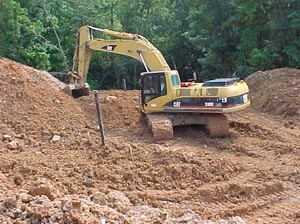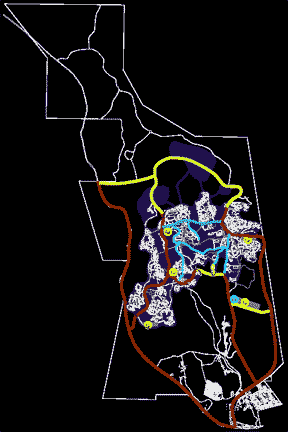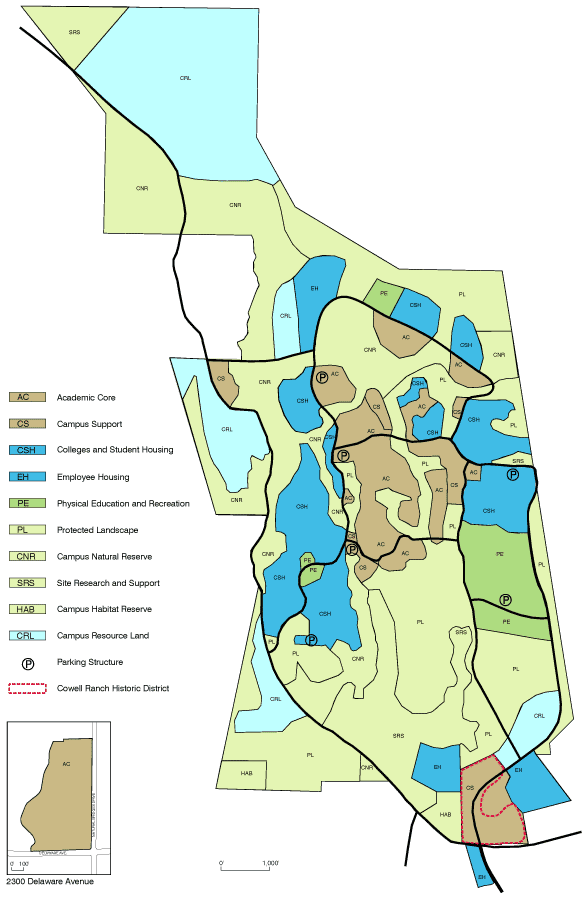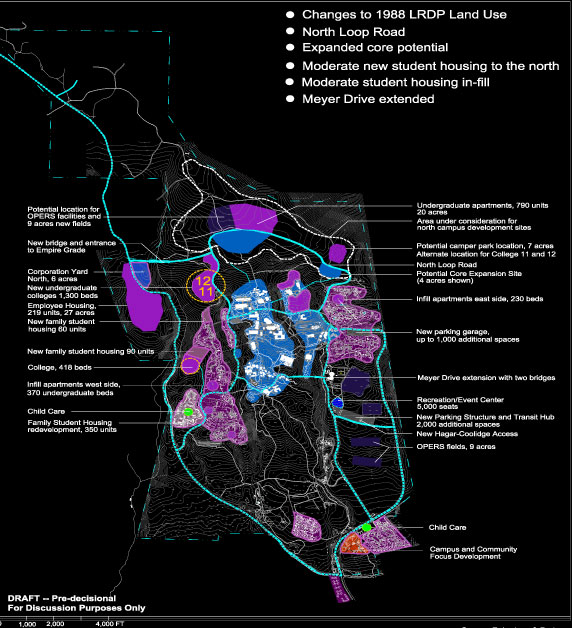UCSC Long Range Development Plan (LRDP)
Here is what the University plans to do and what affect it will have. These details are from the current Long Range Development Plan (LRDP).

- First draft of LRDP was completed October 4, 2004 (try this link if the UCSC URL fails)
- UCSC is expected to grow from a current student population of approximately 14,000 students to 21,000 full time students by the year 2020-with a growth rate of 400 new students per year. This is an increase of about 45%.
- 65% of new development will be in the core of campus (infill development)—which means that 35% will occur in semi-wild areas in the north of campus.
- It is estimated that UCSC would need $400 million dollars to develop north campus.
- Construction will destroy habitat for many species:

The growth of UCSC necessitates the destruction of the habitats of many species and leaves fragmented and decimated ecosystems in its wake.
One species in the area, the Santa Cruz Manzanita, is listed as rare and most of this species within campus lives in an area where the heaviest development is planned. In addition, two habitats in the area, the northern maritime chaparral and the native coastal prairie are both rare and unique communities that will be directly affected by development. - The LRDP will almost double the existing buildings and infrastructure on campus.
- The LRDP expands the “academic core” (primarily academic buildings near the center of campus) to encompass approximately 134 acres.
The college arc (residential areas) will surround the core and in the LRDP will expand to 214 acres.
28 acres of now undeveloped land will be turned into faculty housing.
14 acres of undeveloped land will become “recreation facilities.”
33 acres of undeveloped land in the far north of campus will be designated for “site research and support”, meaning that they will primarily become buildings associated with social sciences, Physical and Biological Sciences, Student Services, and Public Services.
 A new “loop road” will be built along what is now Chinquapin fire road and will connect Heller (above the North Remote Parking Lot) to McLaughlin, through what is now wild habitat areas for numerous species. This road will also extend out through the Cave Gulch area to Empire Grade, which will become a third entrance to the University, and will thus heavily increase traffic on Empire Grade. New roads are shown in yellow in the map to the right.
A new “loop road” will be built along what is now Chinquapin fire road and will connect Heller (above the North Remote Parking Lot) to McLaughlin, through what is now wild habitat areas for numerous species. This road will also extend out through the Cave Gulch area to Empire Grade, which will become a third entrance to the University, and will thus heavily increase traffic on Empire Grade. New roads are shown in yellow in the map to the right.
- One new connecting road will also extend Meyer Drive (connecting Meyer Drive to Hagar Drive) and another will connect Hagar Drive to Coolidge Drive.
- As many as 3,100 new parking spaces will be put in.
- Development will drastically increase traffic and pollution:
In Fall 2003, the average daily traffic was 15,321 vehicle trips at the campus' main entrance and 9,592 at the west entrance—an average of 1.703 trips per student. With 21,000 students such as UCSC is proposing to have by the year 2020, this will increase to approximately 36,000 vehicle trips per day. - New growth will also put a strain on water in the Santa Cruz area, which is already greatly stressed from overuse by agriculture and current populations:
At 15,000 students the University will consume 408 million gallons of water a year. At 21,000 students approximately 571 million gallons of water would be consumed each year.
There are possible plans to begin pumping from on campus wells that could have a severe impact
on local streams. Another plan is to build a desalinization unit, which also has severe environmental consequences.
Desal is not a worry-free technology. Large inputs of fossil fuels are required to run these plants, which contribute to global warming among other obvious drawbacks. They also provide as a byproduct, brine, concentrated salt water, which cannot be disposed of easily either on land or at sea without poisoning the inhabitants. Desal water is expensive water and will mean that water costs will go up.
- Because of the proximity to Bonny Doon and the small community of Cave Gulch, the development of Upper Campus (especially in terms of water usage and developing new wells) will especially impact these communities.
- Development will not only push to develop UC land, but will also push the city to develop 2,167 new housing units on Unincorporated land (previously un-developed and semi-wilderness areas) by 2007.
- The LRDP might also result in the demolition of the UCSC Camper Trailer Park, one of the few spots of real community on campus. The current site of the Trailer Park is the proposed location of Colleges 11 and 12. However, student outcry about the destruction of the Trailer Park has brought the situation to a point where the Trailer Park is now “penciled in” to the LRDP—meaning that it might stay where it is, it might be relocated, or it might be taken out altogether, depending upon the decisions of the administration. The administration is creating a series of ridiculous fire regulations that are increasingly difficult to pass, seemingly as a way to harass the Trailer Park community without outwardly kicking them out. This is an invaluable place that is important to save.
An interesting side-note on the creation of the UCSC trailer park: the park was created as a result of extremely high housing costs during the eighties, which led to many students living out of their vehicles in UCSC's North Remote parking lot as a protest. Due to the number of students living in their vehicles, the University, after first trying to get rid of them with the UCSC police force, granted a concession, the development of the trailer park, for low-income housing.
Maps
Revised map of area under consideration for development:

Detailed Topographical map (note: some changes have been made to the LRDP since this map was
created)
PHASE 1: Analysis
PHASE 2: Develop Long Range Development Plan Options
PHASE 3: Develop LRDP Draft
- Phase 3 lasted from June 2004–December 2004
- Internal review of preferred plan on August 2, 2004
- First Draft of LRDP made public in October 2004
- LRDP Executive Committee Met
- June 2004, September 2004, October 2004, and November 2004
PHASE 4 (California Environmental Quality Act Process/Environmental Impact Report (EIR))
- Phase 4 will last from December 2004–December 2005
- EIR consultant chosen in August (URS Corp.)
- Notice of preparation given on January 15, 2005
- New draft of LRDP released on January 27, 2005
- EIR scoping period from January–February 2005
- Public scoping meetings for EIR on February 16, 2005
- Draft of EIR to be released September of 2005
- Two public hearings will be held in October and November 2005
- Final Draft of LRDP and EIR will be presented to the UC Regents for consideration in July 2006



 A new “loop road” will be built along what is now Chinquapin fire road and will connect Heller (above the North Remote Parking Lot) to McLaughlin, through what is now wild habitat areas for numerous species. This road will also extend out through the Cave Gulch area to Empire Grade, which will become a third entrance to the University, and will thus heavily increase traffic on Empire Grade. New roads are shown in yellow in the map to the right.
A new “loop road” will be built along what is now Chinquapin fire road and will connect Heller (above the North Remote Parking Lot) to McLaughlin, through what is now wild habitat areas for numerous species. This road will also extend out through the Cave Gulch area to Empire Grade, which will become a third entrance to the University, and will thus heavily increase traffic on Empire Grade. New roads are shown in yellow in the map to the right.


